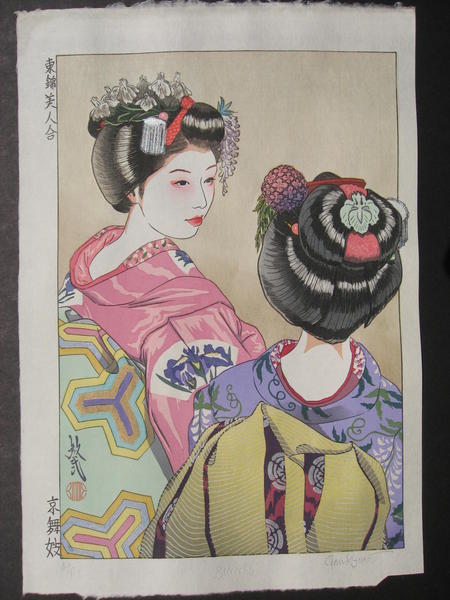| Notes (this edition)?: |
| The following information was taken from the original web listing of this artwork. Note that there may be some inaccuracies:
Saturday, 1 March 2008
I am pleased to announce the completion of 'Kyo Maiko', or Maiko in Kyoto, the newest addition to my series ‘Azuma Nishiki Bijin Awase’ (A Collection of Eastern Brocade Beauties).
As many of you will know, I made two trips to Kyoto last year, in Spring and again in November, the second time for my solo exhibition at Ritsumeikan University, and while I was there the first time, I conceived the idea of this print after seeing a couple of maiko or apprentice geiko (geisha) chatting on the streets of Gion. Since I returned from Japan at the end of November, I have been hard at work printing this image as I intended to submit it to the CWAJ exhibition selection board in Tokyo in February. It has proved to be the most complex print I have made to date – it employs over 50 colours, from gofun, the white pigment used for the girls' make-up, to gold and silver metallic pigments on their obi (sashes) and transparent mica in the silver hair-combs. There is also an unusual karazuri, or blind printing, in the red-pink kanoko cloth inside the bun of the maiko in lilac kimono, which imitates shibori tie-dyed silk crepe and can be seen in raking light, as well as my usual embossed signature in the lower margin.
The two previous ‘Azuma Nishiki’ prints, Cho Musume and Furo Agari, show contemporary young women in kimono, but there is something timeless and picturesque about the costume of maiko, and it has proved fascinating to generations of artists in both woodblock prints and Nihonga, traditional Japanese painting. The next print I am planning in this series will be very different and somewhat more contemporary, and the majority of my prints for 2008 will be female subjects.
Also connected to the Kyoto trips, I gave a printmaking demonstration at Ritsumeikan University, and the new kappazuri design I made there in mixed woodblock and kappazuri technique will be released in a few weeks. It is my first Kabuki subject for ten years, and is a shikishiban caricature of Nakamura Shikan. Incidentally, the book of my Kyoto exhibition, and my ‘First 100 Japanese Prints’, called ‘Paul Binnie; A Dialogue with the Past’ by Kendall Brown, Akama Ryo and Paul Griffith, editited by Eric van den Ing, is available from the publishers Art Media Resources - http://www.artmediaresources.com/item.cfm/100190 - or on amazon.com at only $49, or £25. I would advise anyone interested in my prints, or who may already own any of them, to acquire a copy as soon as possible, as it is selling surprisingly quickly.
Paul Binnie
London, February 2008 |
|
| Artist Bio: |
Paul Binnie was born at Airthrey Castle, Scotland in 1967 and lived in Alloa, Central Scotland until 1985. He then attended Edinburgh University and Edinburgh College of Art, taking his MA (Fine Art) in 1990. From then until the spring of 1993 he lived in Paris where he worked mostly in oils and watercolours, painting figure subjects and occasional landscapes. He began to collect Japanese Woodblock Prints in the late 1980s on a summer trip to Paris, and his extended stay in France allowed him to expand his collection and his knowledge of the subject. It was this interest in Japanese Prints along with a desire to understand the methods of their production that prompted him to move in March 1993 to Tokyo. He there sought training in the techniques of block print-making. Unable to enter the Yoshida studio, his first choice for training, due to the illness of Yoshida Toshi, he was advised to contact Seki Kenji. Kenji had been the head printer at Doi-Hangaten and Binnie worked with him for several years developing his own block printing style.
|
|


